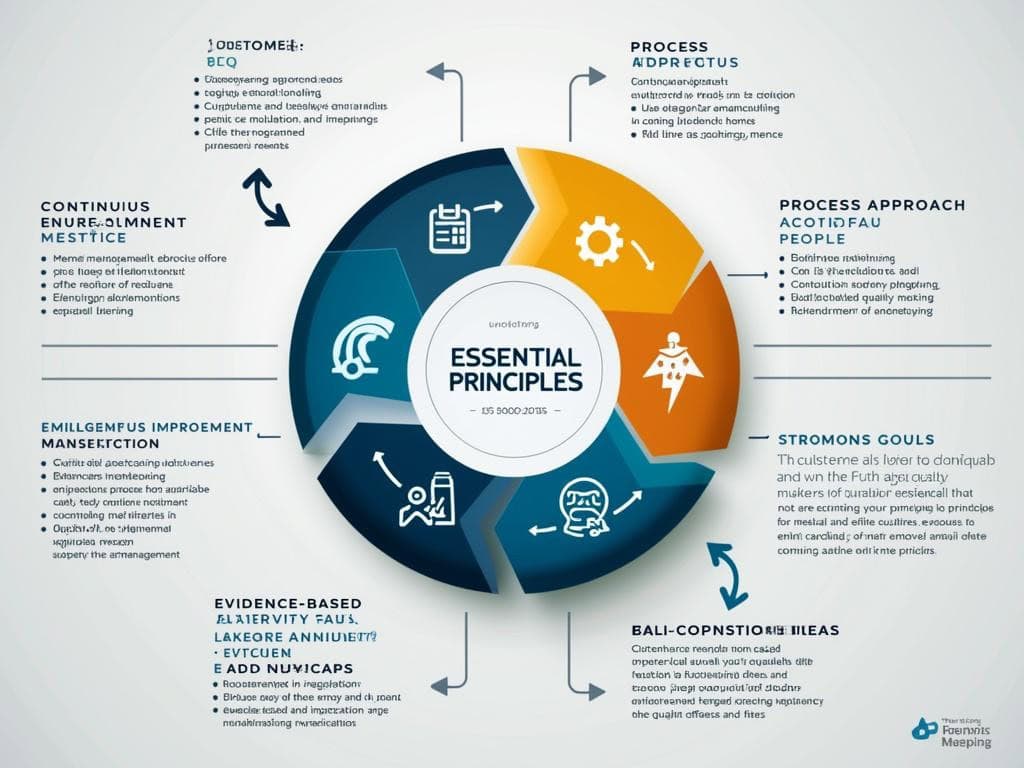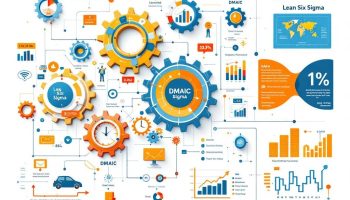
Quality Management: A Strategic Approach to Organizational Excellence
Quality management functions as a strategic approach to organizational excellence, providing a complete framework for performance improvement across all operational areas. Based on the ISO 9001:2015 standard, this quality management example outlines seven essential principles that transform business operations, ensuring you consistently deliver value to customers and stakeholders.
Key Takeaways:
- Quality management is a systematic approach to achieving organizational excellence through structured principles and methodologies.
- Customer focus remains the primary driver of quality management strategies.
- Leadership plays a critical role in establishing unity of purpose and engaging employees.
- Continuous improvement is essential for maintaining relevance and competitiveness.
- Implementing quality management can lead to significant improvements in efficiency, customer satisfaction, and overall organizational performance.
The foundation of effective quality management lies in its application to your daily operations. By integrating these principles into your business processes, you’ll create a quality management system that supports long-term success. These methodologies don’t just enhance product quality—they transform your entire organizational approach.
Research indicates that companies with strong quality management practices experience up to 30% higher customer retention rates. This practical framework helps you identify opportunities for improvement while maintaining focus on what matters most: delivering consistent value to your customers.
For businesses new to quality management, starting with a clear assessment of your current processes will establish a baseline for ISO 9001 compliance and continuous improvement efforts. The journey toward quality excellence requires commitment but yields substantial benefits in market position, operational efficiency, and customer loyalty.
“Embracing quality management as a strategic framework not only streamlines operational excellence but also ensures a relentless focus on customer value. By fostering leadership, unity, and continuous improvement, organizations can achieve unparalleled efficiency and satisfaction in their pursuit of lasting success.”
Foundational Principles of Quality Management
Quality management forms the backbone of organizational excellence. Based on the ISO 9001:2015 standard, it encompasses seven key principles that serve as an example of quality management in action. These principles aren’t just theoretical concepts—they’re practical guidelines that transform how you operate your business.
Customer focus stands as the primary principle of quality management. You need to understand your customers’ current and future needs to consistently meet their expectations. This approach helps you maintain relevance in competitive markets while building customer loyalty through responsive service delivery.
Leadership plays a crucial role in quality management by establishing unity of purpose. When leaders create conditions where people become fully engaged in achieving quality objectives, the entire organization benefits. This example of quality management demonstrates how proper leadership creates alignment between organizational goals and quality initiatives.
Employee engagement represents another foundational element. Engaged employees contribute their abilities fully to deliver value. By involving your team members in quality processes, you’ll tap into their expertise while fostering a culture of ownership and accountability in continuous improvement efforts.
Key Focus Areas for Quality Excellence
Understanding and exceeding customer expectations requires systematic feedback collection. You should implement regular surveys, focus groups, and customer journey mapping to identify improvement opportunities. This example of quality management helps you anticipate future needs rather than simply reacting to complaints.
Creating alignment between organizational objectives and quality goals ensures your quality management efforts support broader business strategies. You’ll need to develop clear quality policies that connect directly to your mission statement and strategic plans. This alignment is an essential example of quality management that prevents isolated improvement initiatives.
Establishing a culture of continuous improvement means embracing change as opportunity. You should encourage employees to identify process inefficiencies and implement solutions. This example of quality management fosters innovation by rewarding problem-solving rather than blame assignment.
| Goal | Description | Impact |
|---|---|---|
| Enhanced Organizational Performance | Streamlined processes and reduced waste | Improved efficiency and productivity |
| Increased Customer Satisfaction | Meeting or exceeding expectations | Higher retention and word-of-mouth referrals |
| Improved Risk Management | Proactive identification of potential issues | Reduced disruptions and crisis situations |
| Stronger Competitive Position | Differentiation through quality | Market share growth and premium positioning |
Implementing these foundational principles requires commitment and strategic planning. When properly executed, this example of quality management transforms organizations by creating sustainable excellence that delivers value to all stakeholders.

Strategic Quality Management Systems
Strategic Quality Management Systems provide the essential framework for organizations to deliver consistent excellence across all operations. You need structured approaches to quality management to meet and exceed customer expectations while driving continuous improvement. An example of quality management in action is when companies implement ISO 9001 standards to standardize their quality processes and reduce defects.
These systems focus on documenting procedures, implementing risk management strategies, and establishing performance monitoring mechanisms. Your organization can benefit from these systems by creating clear protocols that everyone follows. This consistency helps eliminate errors and enhances overall product or service quality.
Core Elements of Effective Quality Systems
A robust quality management system includes several critical components that work together to ensure excellence:
- Documented procedures that standardize work processes
- Risk management protocols to identify and mitigate potential issues
- Performance monitoring tools to track progress and outcomes
- Feedback mechanisms to gather insights from customers and employees
- Continuous improvement processes to refine operations
Quality management requires a strategic approach to implementation. When you implement key project phases for your quality management system, you’ll see measurable improvements in performance.
The right metrics are essential for tracking quality performance. Common quality benchmarks include defect rates, customer satisfaction scores, and process cycle times. These indicators help you assess the example of quality management practices within your organization and identify areas for improvement.
Many organizations utilize continuous improvement methodologies to enhance their quality management systems. This iterative approach ensures your quality processes remain relevant and effective even as market conditions change.
Effective quality management depends on employee engagement and understanding. Your team members need proper training to recognize the importance of quality in their daily work. When everyone understands how their role contributes to overall quality, they become more invested in maintaining high standards.
A strategic quality management system aligns with your broader organizational goals. This alignment ensures that quality initiatives support your business objectives rather than existing as separate activities. The example of quality management integration can be seen when companies incorporate quality metrics into their strategic planning and performance evaluations.
Expert Insight: To excel in Strategic Quality Management Systems, focus on integrating quality initiatives with your organization’s overarching goals, ensuring they support your business objectives. Implement documented procedures, risk management protocols, and performance monitoring tools to create a robust framework that enhances consistency and reduces errors. Finally, foster employee engagement through training, emphasizing the crucial role each team member plays in achieving high standards of quality.
Advanced Quality Methodologies
Advanced quality methodologies serve as powerful frameworks for implementing systematic quality management within your organization. These structured approaches represent important examples of quality management that drive consistent excellence across all operations.
Quality management methodologies give you specific tools to enhance performance, reduce waste, and deliver superior products or services. Each approach offers unique advantages depending on your organizational needs and objectives.
Major Quality Management Approaches
Total Quality Management (TQM) focuses on creating a quality-centered culture where every employee takes responsibility for excellence. This example of quality management emphasizes customer satisfaction, continuous improvement, and total organizational involvement. You’ll find TQM particularly valuable when building a quality-focused culture from the ground up.
Six Sigma uses statistical analysis to identify and eliminate defects in processes. This data-driven example of quality management aims to achieve 3.4 defects per million opportunities. The DMAIC methodology (Define, Measure, Analyze, Improve, Control) provides a structured approach to continuous improvement within your operations.
Lean Manufacturing focuses on eliminating waste in all forms – including time, resources, and effort. This example of quality management streamlines processes to maximize value from the customer’s perspective. Value stream mapping helps you visualize workflows and identify inefficiencies that impact quality outcomes.
Lean Six Sigma combines waste reduction principles with defect elimination methodologies. This hybrid example of quality management blends statistical analysis with streamlined processes. You’ll gain tools like Kanban for workflow visualization and 5S techniques (Sort, Set, Shine, Standardize, Sustain) for workplace organization.
When selecting a quality methodology, consider your specific challenges and objectives. Each framework offers distinct advantages for process optimization:
| Methodology | Primary Focus | Key Tools | Best For |
|---|---|---|---|
| TQM | Cultural transformation | Cross-functional teams, quality circles | Organizations seeking holistic improvement |
| Six Sigma | Defect reduction | DMAIC, statistical analysis | Process-heavy operations with measurable outputs |
| Lean | Waste elimination | Value stream mapping, 5S | Organizations with significant inefficiency |
| Lean Six Sigma | Efficiency and quality | Combined Lean and Six Sigma tools | Complex operations requiring comprehensive improvement |
Implementing these quality methodologies requires systematic training and proper execution. You’ll need to select appropriate tools from each framework to address your specific quality challenges. The right example of quality management methodology transforms how you approach excellence throughout your organization.
Companies that adopt quality management practices can see up to a 30% increase in productivity and 25% reduction in costs.
forbes.com
Implementation Strategies
Successful quality management implementation requires a structured approach focused on execution excellence. Your organization needs practical strategies to transform quality principles into daily operations. An example of quality management implementation can be seen when organizations deploy comprehensive training programs alongside performance monitoring systems.
Employee Training and Empowerment
Empowering your team with the right knowledge forms the foundation of quality management success. Effective training programs ensure everyone understands quality standards and their role in maintaining them. Consider these essential training components:
- Role-specific quality procedure training
- Problem-solving and root cause analysis techniques
- Quality tool application workshops
- Cross-functional quality awareness sessions
- Leadership quality management responsibilities
Data-driven performance monitoring allows you to track quality metrics continuously. Implementing a robust monitoring system helps identify trends, spot issues early, and validate quality improvements. Dashboard and scorecard systems drive performance by visualizing key quality indicators and making data accessible to decision-makers.
Regular satisfaction surveys provide critical feedback on both internal processes and external perceptions. These surveys should target customers, employees, and partners to gather comprehensive quality insights. Using standardized measurement tools ensures you can track improvement over time.
Leadership accountability creates the cultural foundation for quality management. When leaders demonstrate commitment to quality principles through their actions and decisions, it reinforces the example of quality management throughout the organization. Effective project leadership includes setting clear quality expectations and consistently following through on quality commitments.
Supplier and stakeholder relationship management extends your quality focus beyond internal operations. By integrating suppliers into your quality systems and establishing clear performance standards, you create an extended quality network. Regular performance reviews, quality audits, and collaborative improvement initiatives help maintain quality throughout your supply chain.
| Implementation Strategy | Primary Benefit | Secondary Benefit |
|---|---|---|
| Employee Training | Knowledge Transfer | Cultural Alignment |
| Performance Monitoring | Real-time Insights | Continuous Improvement |
| Satisfaction Surveys | Stakeholder Feedback | Service Enhancement |
| Leadership Accountability | Cultural Reinforcement | Organizational Alignment |
| Relationship Management | Extended Quality Control | Risk Reduction |
When implementing these strategies, consider adopting continuous improvement methodologies to refine your approach over time. Each example of quality management implementation should be viewed as an ongoing process rather than a one-time initiative.
Expert Insight: To successfully implement quality management, adopt a structured approach that emphasizes effective employee training and empowerment. Provide role-specific training, problem-solving workshops, and leadership accountability to ensure that all team members understand their quality responsibilities and contribute to a culture of excellence. Enhance your implementation strategy by utilizing data-driven performance monitoring and regular stakeholder feedback to track progress and drive continuous improvement across the organization.
Practical Applications and Benefits
Quality management delivers tangible advantages when implemented strategically across your organization. A structured example of quality management demonstrates how these principles transform business performance and customer relationships.
Your operational efficiency improves dramatically through quality management implementation. By standardizing processes and eliminating wasteful activities, you’ll reduce production time by up to 30% while maintaining consistency. Companies that implement continuous improvement practices report an average 15-20% reduction in operational costs within the first year.
Customer loyalty strengthens when quality becomes your priority. Research shows organizations with robust quality management systems achieve 25% higher customer retention rates than competitors. This loyalty translates directly to your bottom line, as acquiring new customers costs five times more than retaining existing ones.
You’ll gain competitive market advantages by implementing quality standards. Consider these key benefits:
- Reduced defect rates and rework requirements
- Decreased customer complaints and warranty claims
- Optimized resource utilization across departments
- Enhanced employee engagement and reduced turnover
- Improved regulatory compliance and risk management
The financial impact of quality management provides a compelling example of its value. The following table illustrates typical return on investment metrics:
| Quality Management Area | Average ROI | Implementation Timeframe |
|---|---|---|
| Process Standardization | 200-300% | 6-12 months |
| Defect Reduction | 150-250% | 3-9 months |
| Employee Training | 100-200% | Ongoing |
| Customer Satisfaction | 300-500% | 12-24 months |
Organizational Reputation Building
Your company’s reputation strengthens through quality management certification. Organizations with ISO 9001 certification report 50% more tender opportunities and 37% higher success rates in competitive bidding situations. This certification serves as an example of quality management commitment that signals reliability to potential partners and customers.
Employee satisfaction increases when quality management processes provide clear direction and standards. Staff report higher engagement when they understand how their work contributes to organizational excellence. This alignment reduces turnover costs and preserves institutional knowledge.
The example of quality management impact extends beyond financial metrics to include sustainability benefits. By optimizing resource usage and minimizing waste, you’ll reduce environmental impact while improving operational efficiency. This dual benefit positions your organization favorably with environmentally conscious consumers and regulatory bodies.
Implementing Quality Management: Next Steps
Starting a quality management journey demands a strategic approach. You’ll need a clear roadmap to transform your organization through proper implementation of quality management systems. Let’s examine the crucial steps to successfully embed quality management principles into your operations.
Quality Assessment and Implementation Strategy
Begin by conducting a comprehensive organizational quality assessment to identify gaps and opportunities. This assessment serves as the foundation for your quality management initiative. You’ll want to examine current processes, documentation, and performance metrics to establish your baseline.
After assessment, select the appropriate quality management methodology that aligns with your organizational goals. Each approach offers unique benefits:
- Total Quality Management (TQM) emphasizes organization-wide quality commitment
- Six Sigma focuses on reducing process variation and defects
- Lean Manufacturing targets waste elimination
- Lean Six Sigma combines waste reduction with defect minimization
With methodology selected, develop a customized implementation strategy that includes:
- Clear quality objectives aligned with business goals
- Realistic timelines for implementation phases
- Resource allocation requirements
- Specific roles and responsibilities
Employee training represents a critical example of quality management in action. Your workforce needs the skills and knowledge to apply quality principles effectively. Invest in comprehensive training programs that cover quality fundamentals, specific methodologies, and practical tools.
The following table summarizes the key elements of a successful quality management implementation:
| Implementation Component | Purpose | Example Activities |
|---|---|---|
| Quality Assessment | Establish baseline | Process audits, performance analysis |
| Methodology Selection | Match approach to needs | Stakeholder workshops, cost-benefit analysis |
| Implementation Strategy | Create roadmap | Action planning, resource allocation |
| Employee Training | Build capability | Workshops, certification programs |
| Monitoring Process | Ensure sustainability | KPI tracking, regular reviews |
Establish robust monitoring systems to track progress and ensure continuous improvement. Your quality control methods should include regular performance reviews, customer feedback analysis, and internal audits.
External certification, such as ISO 9001, can validate your quality management system and demonstrate your commitment to excellence. Pursuing certification provides structure and external validation for your quality initiatives while potentially opening new market opportunities.
Throughout implementation, maintain project communication with all stakeholders to ensure alignment and buy-in. Your leadership team must visibly champion quality management initiatives for successful adoption across the organization.
The example of quality management implementation shows that quality isn’t a one-time project but an ongoing commitment. By following these structured steps, you’ll create a sustainable quality culture that delivers consistent value to customers and stakeholders while driving organizational performance.






